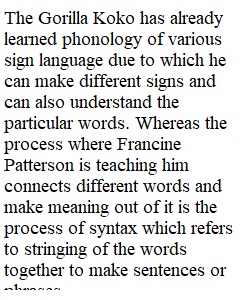


Q Mastery of any language can be divided into two basic components: comprehension and production. Human children learn to comprehend before they can produce language. There are four rules for production: Phonology: making meaningful sounds Morphology: combining phonemes into words Syntax: rules that specify where words go to make meaningful sentences Semantics: what words or phrases mean in a given sentence or context Check the highest level you think the animal has attained; be sure to remember that sign language is a language and the production of words do not have to be oral. Give reasoning as to why you chose the answer that you did. Also, keep in mind that the following situations are regarding animal language and animal research, so be sure to look at what evidence may provided within the context. Koko the gorilla was trained by Francine Patterson to use sign language. The Gorilla language Project reports that Koko can use 1000 different signs, and can understand 2000 words. Koko is now creating statements by blending three to six words. Choose the highest level that the animal may have attained and explain why you chose your choice. Select one: a. Phonology b. Morphology c. Syntax d. Semantics Nim Chimpsky (chimpanzee) was trained by Herbert Terrance to understand sign language. Terrance was skeptical of many former chimp experiments. Nim learned 125 signs, but Terrance realized that Nim seemed to simply be responding to signs that the researchers presented rather than understanding their meaning. Choose the highest level that the animal may have attained and explain why you chose your choice. Select one: a. Phonology b. Morphology c. Syntax d. Semantics In 1952, researchers Hayes and Hayes tried to teach their chimpanzee (Vickie) to speak the English language. Vickie learned how to make four sounds, but never produced anything that sounded much like language. Choose the highest level that the animal may have attained and explain why you chose your answer. Select one: a. Phonology b. Morphology c. Syntax d. Semantics Alex (an African grey parrot) was trained by Irene Pepperberg. Alex could say 70 words, including nouns, verbs, and adjectives. Alex could also identify colors and textures, use the numbers from one to five, and could report if the objects are the same or different. Choose the highest level that the animal may have attained and explain why you chose your answer. Select one: a. Phonology b. Morphology c. Syntax d. Semantics Herman, Richards, and Woltz (1984) trained dolphins to understand hand commands. Their dolphins could understand five-sign strings, as well as some rules of language. For instance, their dolphins Phoenix and Akeakamai, understood the order words had to be in to perform a certain command. Choose the highest level that the animal may have attained and explain why you chose your answer. Select one: a. Phonology b. Morphology c. Syntax d. Semantics
View Related Questions